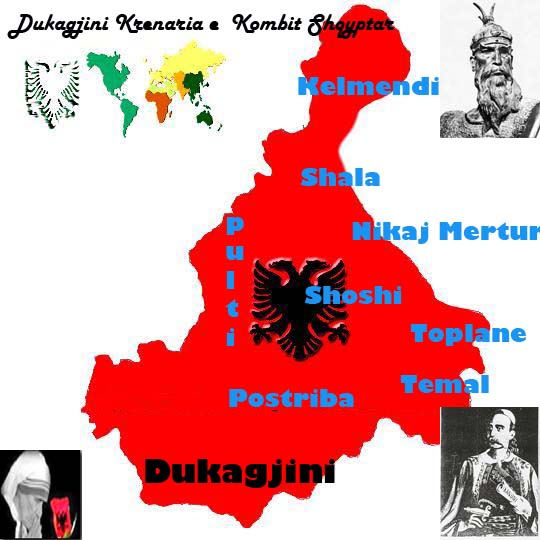Dukagjini is a region in Northern Albania and western Kosovo,[a] which contains the Prokletije, an extension of the Dinaric Alps range. The highest point is Maja Jezerce (2694 m).
It is inhabited by nine fraternal tribes;
- Shala
- Shoshi
- Nikaj
- Merturi
- Shllaku
- Temali
- Xhani
- Kiri
- Plani
All nine tribes within Dukagjini belong to the Roman Catholic faith, although the Dukagjini of Kosovo is primarily considered Muslim. Today, the region is a part of the Shkodër district in Albania, except for the Merturi tribe, which is part of the Tropojë district in Albania
The name "Dukagjini" derives from Lekë Dukagjini, the unifier and legislator of the Albanian highland law, the Kanun. Leka became leader of the Albanian resistance against Turkish onslaught, right after the death of Skenderbeg. He fought bravely aside with his men for another thirteen years until his death.
[edit]History
The Dukagjini region of Northern Albania and Western Kosovo was first created under the leadership of Prince Pal Dukagjini (father of Leka Dukagjini) in around the late 1300s. The original capital of the once princedom was Ulpiana (modern Lipjan), which is now in Kosovo. Lipljan was indeed the birthplace of Lekë Dukagjini, although other sources claim he was born in the Northern Albanian Alps. Roman Catholicism claimed to be the official religion of the region until the invasion of the Turks, forcing most of the Kosovo part of the region to convert to Islam, while the rest of the region still managed to defend their faith.
Throughout all of the 500 years of Turkish dominance, the region of Dukagjini did acquire most independence of all Albanian lands, along withMalësi e Madhe. Bravery, rough terrain, and unity kept this region from falling to the Turks, as did several other Albanian regions and districts. Dukagjini did reach its climax under the leadership of Lekë Dukagjini, who was Prince right after his father Pal. As a dedicated Prince, Leka managed to spread the concept of unity through his works of the "Kanun", this Kanun was later to be called "Kanuni i Lekë Dukagjinit" as proclaimed by the great Gjergj Kastrioti himself. Leka also managed to defend the Albanian lands from the Ottoman's for another 13 years after Gjergj Kastrioti's death, when finally it had fallen to them on the year of 1480.
After the death of Leka, the region was no more a princedom but rather a region of lesser hierarchy. Instead of a central power, the region was broken down to smaller powers that acted as one in maintaining unity throughout the whole region. The smaller powers were handed to the Bajraktar (flagbearer) of each Bajrak, meaning tribe.

Nuk i ke rreshtue si duhet emnat e Fshatrave si perbajn Dukagjinin..
RispondiElimina